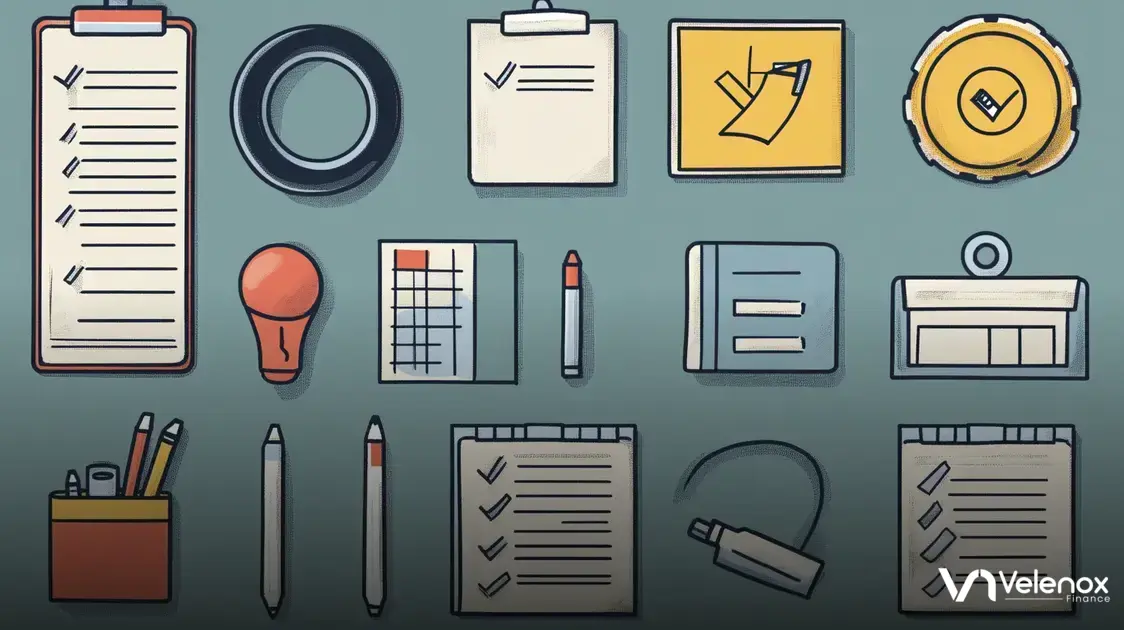Managing your finances can be daunting, but with personal budgeting tools, it becomes a breeze.
These tools offer users an efficient way to track spending, create budgets, and reach financial goals.
Prepare to take control of your financial future!
What Are Personal Budgeting Tools?
Personal budgeting tools are digital applications designed to help individuals manage their finances effectively.
They allow users to track income, expenses, and savings, making budgeting easier and more efficient.
These tools come in various forms, including mobile apps, desktop software, and web-based platforms.
With personal budgeting tools, you can categorize spending, see where your money goes, and set financial goals.
Some tools even allow for bank account synchronization, giving users real-time insights into their financial situation.
Types of Personal Budgeting Tools
There are several types of personal budgeting tools available:
- Mobile Apps: These are convenient tools that you can use on the go. They often come with features like expense tracking and budget creation.
- Desktop Software: This type of budgeting tool offers more robust features and may be better for detailed analysis. Users can create complex budgets with extensive reports.
- Web-Based Platforms: These tools require no installation and can be accessed from any device with internet access. They usually offer collaboration features for families or couples.
In summary, personal budgeting tools provide essential support to manage your finances and achieve your savings goals.
Benefits of Using Personal Budgeting Tools
Personal budgeting tools offer numerous benefits that can help individuals manage their finances more effectively.
These tools simplify the budgeting process and provide valuable insights into spending habits.
Track Spending
One of the main advantages is the ability to track spending in real-time.
Users can categorize expenses easily, making it clear where money goes each month. This awareness helps in identifying unnecessary expenditures.
Set Goals
Personal budgeting tools allow users to set savings goals.
Whether saving for a vacation or paying off debt, having a clear goal can motivate users to stay on track.
Financial Visualization
Visual representations of finances, such as charts and graphs, make it easier to understand expenses, income, and savings.
This clarity helps users make informed decisions about their finances.
Automate Tasks
Many budgeting tools can automate repetitive tasks, such as bill payments and transaction recordings.
Automation saves time and reduces the chances of forgetting payments.
Analyze Patterns
By analyzing spending patterns, users can spot trends and make adjustments.
This analysis can lead to better financial habits and improved budgeting strategies.
Stay Accountable
Using a budgeting tool can help individuals stay accountable.
By regularly reviewing their budgets, users can maintain discipline in spending and saving, leading to better financial health.
Easy Adjustments
As income and expenses change, personal budgeting tools make it easy to adjust budgets accordingly.
This flexibility ensures that users can adapt their financial plans to meet new challenges.
How to Choose the Right Budgeting Tool

Choosing the right budgeting tool is essential for effective financial management. Here are some key factors to consider:
Identify Your Needs
Start by identifying what you need from a budgeting tool.
Are you looking for simple expense tracking, or do you want advanced features like investment tracking?
Understanding your requirements will help narrow down your options.
Research Available Options
Take the time to research different budgeting tools available.
Check user reviews to see what other people have experienced. Compare features, usability, and prices to find tools that meet your needs.
Consider User Experience
A user-friendly interface is vital for a budgeting tool.
Choose one that is easy to navigate. Good design makes it easier to track finances without feeling overwhelmed by complex features.
Look for Automation Features
Automation can save you time and effort.
Look for tools that allow for automatic syncing with bank accounts and automatic bill payment reminders. These features can simplify your budgeting process.
Check for Compatibility
Make sure the budgeting tool is compatible with your devices.
Some tools work as mobile apps, while others are web-based. Choose one that fits well within your tech ecosystem.
Evaluate Security Measures
When sharing financial information, security is crucial.
Check what security measures the tool has in place. Look for tools with encryption and two-factor authentication to keep your data safe.
Test with a Free Trial
If available, take advantage of a free trial. This trial will allow you to test the tool’s features before making a commitment.
Ensure that it works well for your specific needs.
Top Personal Budgeting Tools in 2023
In 2023, several personal budgeting tools stand out for their features and usability. Here are some of the top options:
1. Mint
Mint is a popular free budgeting app that helps users manage their finances in one place.
It automatically syncs with your bank accounts and categorizes transactions, making it easy to see your spending habits.
2. YNAB (You Need A Budget)
YNAB focuses on helping users take control of their spending through proactive budgeting.
It offers educational resources to teach budgeting strategies, although it has a monthly fee after a free trial.
3. PocketGuard
PocketGuard simplifies budgeting by showing users how much they have left to spend after bills, goals, and necessities.
Its user-friendly interface is perfect for those who want quick insights into their finances.
4. EveryDollar
EveryDollar is a straightforward budgeting tool created by financial expert Dave Ramsey.
It allows users to build a zero-based budget, making sure that every dollar has a job. There is a free version and a premium version for added features.
5. Personal Capital
Personal Capital is a great choice for those interested in both budgeting and investment tracking.
It provides financial tools for budgeting while also offering insights into investment performance.
6. GoodBudget
GoodBudget is a virtual envelope system that helps users allocate their income to various spending categories.
This app is great for users who prefer an envelope budgeting method.
7. Clarity Money
Clarity Money helps users track spending and provides personalized recommendations to save money.
Its features include budgeting tools and account management, all in a sleek user interface.
8. Zeta
Zeta is designed for couples, allowing them to manage their finances together.
It offers shared budgets and expense tracking, making it easier for partners to handle joint finances.
How to Set Up Your Budgeting Tool
Setting up your budgeting tool can be simple if you follow these steps:
1. Choose Your Tool
First, pick the budgeting tool that suits your needs.
Whether it’s an app or software, ensure it aligns with your financial goals.
2. Create an Account
Once you’ve selected your tool, create an account.
This process usually involves providing your email and setting a password. Make sure to choose a strong password for security.
3. Link Your Accounts
Most budgeting tools allow you to link your bank accounts for automatic tracking.
Follow the prompts to securely connect your financial accounts. This step helps you see your whole financial picture.
4. Set Up Your Budget Categories
Create categories for your spending, such as groceries, entertainment, and savings.
Use the tool’s features to assign amounts for each category based on your income.
5. Input Your Income
Add your income sources, such as salary or side jobs.
This information is crucial for creating a realistic budget. Be sure to include all regular income streams.
6. Track Your Expenses
Start using the tool to track your daily expenses. Input transactions manually or rely on automatic syncing.
Regularly updating your spending will help you stay on top of your budget.
7. Review and Adjust
After a month or so, review your budget. Check if you’re sticking to your categories or spending too much in one area.
Adjust your budget as needed for better accuracy.
8. Set Financial Goals
Utilize your budgeting tool to set financial goals.
Whether saving for a vacation or paying off debt, having clear objectives will keep you motivated.
Common Mistakes to Avoid with Budgeting Tools

Using budgeting tools can be very helpful, but there are common mistakes to avoid to ensure you get the most benefit:
1. Not Setting Clear Goals
Jumping into budgeting without clear financial goals can lead to confusion.
Always define what you want to achieve, like saving for a vacation or paying off debt.
2. Failing to Track Expenses Regularly
One mistake is neglecting to track your expenses consistently.
Regular tracking helps you stay updated on your spending and make necessary adjustments.
3. Overcomplicating the Budget
Creating a budget that is too complex can be overwhelming.
Stick to a simple format that clearly outlines your income and expenses to avoid getting lost in details.
4. Ignoring Small Expenses
Many people focus only on major expenses and overlook small purchases.
Small items can add up quickly, so always account for these in your budget.
5. Not Reviewing the Budget Frequently
Setting a budget and forgetting about it is a common mistake. Review your budget monthly to ensure it still reflects your financial situation and goals.
6. Relying Solely on Automation
While automation can help with tracking, don’t rely solely on it. Manually review your finances to catch any discrepancies or mistakes.
7. Not Adapting to Changes
Life changes such as a new job or unexpected expenses can affect your budget. Be ready to adapt your budget accordingly to stay on track.
8. Comparing with Others
Everyone’s financial situation is different. Avoid comparing your budget with others, as this can lead to unrealistic expectations and financial stress.
Tips for Effective Budgeting
Effective budgeting can lead to better financial health. Here are some practical tips to enhance your budgeting:
1. Set Realistic Goals
Start by setting achievable financial goals. Your goals should be specific, measurable, and time-bound. This focus will help guide your budgeting process.
2. Track All Spending
Use your budgeting tool to track every penny you spend. Recording all expenses helps reveal where your money goes and highlights areas to cut back.
3. Stick to Your Categories
When creating your budget, set clear categories for different spending areas. Make sure to stick to these categories to maintain discipline.
4. Create an Emergency Fund
Prioritize building an emergency fund to cover unexpected expenses. Aim for at least three to six months’ worth of living expenses for peace of mind.
5. Review Monthly
Schedule a monthly review of your budget. Analyze your spending patterns and make adjustments as needed. This practice keeps you accountable and informed.
6. Use Budgeting Tools
Leverage online budgeting tools or apps to simplify the process. Many tools automate expense tracking and help visualize your financial situation.
7. Reward Yourself
Incorporate small rewards for sticking to your budget. Celebrating your achievements, no matter how small, can keep you motivated to maintain your financial plan.
8. Stay Flexible
Life changes, and so can your financial situation. Be ready to adapt your budget as your circumstances change, like income fluctuations or new expenses.
Integrating Budgeting Tools with Other Financial Apps
Integrating budgeting tools with other financial apps can enhance your financial management. Here’s how you can do it effectively:
1. Determine Your Needs
Before integration, consider what financial aspects you want to manage. Do you need help with investing, savings, or tracking expenses?
Knowing your needs helps you choose the right apps to integrate.
2. Choose Compatible Apps
Look for apps that are known to work well with your budgeting tool.
Many budgeting tools have partnerships with financial apps, making integration seamless. Check the app descriptions for compatibility.
3. Sync Bank Accounts
Connecting your bank accounts to both your budgeting tool and other financial apps can provide a complete view of your finances.
This allows for automatic updates and real-time tracking.
4. Use APIs for Advanced Integration
If you have technical skills, consider using APIs to connect different financial apps.
APIs can facilitate smooth data sharing between applications, enhancing functionality.
5. Set Up Automatic Transfers
Many budgeting tools allow you to set up automatic transfers between accounts.
This feature can help with saving and debt repayment, ensuring you stick to your financial goals without manual effort.
6. Regularly Review Data
After integration, regularly check the information being shared between your apps.
Make sure all data is accurate and up-to-date. This review will help you stay informed about your finances.
7. Utilize Reporting Features
Some financial apps offer detailed reporting features.
Use these reports to analyze spending patterns and make informed financial decisions based on aggregated data from all your apps.
8. Remain Security-Conscious
When integrating multiple financial apps, prioritize security.
Use strong passwords, enable two-factor authentication, and review the security practices of each app to protect your sensitive information.
In Summary: Mastering Personal Budgeting Tools
Using personal budgeting tools effectively can significantly improve your financial health.
By understanding what these tools are and how they can benefit you, you take an important step toward managing your finances better.
Choosing the right budgeting tool and setting it up properly are crucial first steps.
Avoiding common mistakes and applying effective budgeting tips ensures that you remain on track.
Integrating budgeting tools with other financial apps can provide a comprehensive view of your financial situation, allowing for better decision-making.
Ultimately, your journey to financial stability starts with clear goals and the right tools.
Stay proactive, and you will see positive changes in your financial life.





